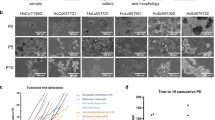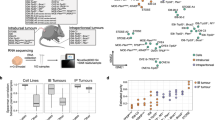Abstract
Aim:
To investigate the anticancer effects of S115, a novel heteroaromatic thiosemicarbazone compound in vitro and in vivo.
Methods:
The anti-proliferative action of S115 was analyzed in 12 human and mouse cancer cell lines using MTT assay. Autograft and xenograft cancer models were made by subcutaneous inoculation of cancer cells into mice or nude mice. The mice were orally treated with S115 (2, 8, 32 mg·kg−1·d−1) for 7 d, and the tumor size was measured every 3 d. Cell apoptosis and cell cycle distribution were examined using flow cytometry, gene expression profile analyses, Western blots and RT-PCR.
Results:
The IC50 values of S115 against 12 human and mouse cancer cell lines ranged from 0.3 to 6.6 μmol/L. The tumor growth inhibition rate caused by oral administration of S115 (32 mg·kg−1·d−1) were 89.7%, 81.7%, 78.4% and 77.8%, respectively, in mouse model of B16 melanoma, mouse model of Colon26 colon cancer, nude mouse model of A549 lung cancer and nude mouse model of SK-OV-3 ovarian cancer. Furthermore, oral administration of S115 (7.5 mg·kg−1·d−1) synergistically enhanced the anticancer effects of cyclophosphamide, cisplatin, or 5-fluorouracil in mouse model of S180 sarcoma. Treatment of A549 human lung cancer cells with S115 (1.5 μmol/L) induced G0/G1 cell cycle arrest, and increased apoptosis. Furthermore, S115 downregulated the level of ubiquitin, and upregulated the level of Tob2 in A549 cells.
Conclusion:
S115 exerts anticancer effects against a variety of cancer cells in vitro and in grafted cancer models by inducing apoptosis, downregulating ubiquitin and upregulating Tob2.
Similar content being viewed by others
Log in or create a free account to read this content
Gain free access to this article, as well as selected content from this journal and more on nature.com
or
References
Brown B, Harris R . Derivatives of N-(pyrid-2-yl) thiourea as root growth inhibitors. Pesticide Sci 1973; 4: 215–25.
Zheng W, Yates SR, Papiernik SK, Guo M . Transformation of herbicide propachlor by an agrochemical thiourea. Environ Sci Technol 2004; 38: 6855–60.
Pandey H, Ram V, Mishra L . Heterocyclic thioureas as pesticides 1979.
Ni C, Yi C, Feng Z . Studies of syntheses and adsorption properties of chelating resin from thiourea and formaldehyde. J Appl Polymer Sci 2001; 82: 3127–32.
Takemoto Y . Development of chiral thiourea catalysts and its application to asymmetric catalytic reactions. Chem Pharm Bull 2010; 58: 593–601.
Susamma A, Mini VTE, Kuriakose A . Studies on novel binary accelerator system in sulfur vulcanization of natural rubber. J Appl Polymer Sci 2001; 79: 1–8.
Khan SA, Singh N, Saleem K . Synthesis, characterization and in vitro antibacterial activity of thiourea and urea derivatives of steroids. Eur J Med Chem 2008; 43: 2272–7.
Abbas SY, Sh El-Sharief MA, Basyouni WM, Fakhr IM, El-Gammal EW . Thiourea derivatives incorporating a hippuric acid moiety: Synthesis and evaluation of antibacterial and antifungal activities. Eur J Med Chem 2013; 64: 111–20.
Phetsuksiri B, Jackson M, Scherman H, McNeil M, Besra GS, Baulard AR, et al. Unique mechanism of action of the thiourea drug isoxyl on Mycobacterium tuberculosis. J Biol Chem 2003; 278: 53123–30.
Manjula SN, Malleshappa Noolvi N, Vipan Parihar K, Manohara Reddy SA, Ramani V, Gadad AK, et al. Synthesis and antitumor activity of optically active thiourea and their 2-aminobenzothiazole derivatives: A novel class of anticancer agents. Eur J Med Chem 2009; 44: 2923–9.
Mehanna AS, Belani JD, Kelley CJ, Pallansch LA . Design, synthesis and biological evaluation of a series of thioamides as non-nucleoside reverse transcriptase inhibitors. Med Chem 2007; 3: 513–9.
Moorthy NS, Cerqueira NM, Ramos MJ, Fernandes PA . Aryl- and heteroaryl-thiosemicarbazones derivatives and its metal complexes: a pharmacological template. Recent Pat Anticancer Drug Discov 2013; 8: 168–82.
Xiong X, Liu H, Fu L, Li L, Li J, Luo X, et al. Antitumor activity of a new N-substituted thiourea derivative, an EGFR signaling-targeted inhibitor against a panel of human lung cancer cell lines. Chemotherapy 2008; 54: 463–74.
Huhtiniemi T, Suuronen T, Rinne VM, Wittekindt C, Lahtela-Kakkonen M, Jarho E, et al. Oxadiazole-carbonylaminothioureas as SIRT1 and SIRT2 inhibitors. J Med Chem 2008; 51: 4377–80.
Rao VA . Iron chelators with topoisomerase-inhibitory activity and their anticancer applications. Antioxid Redox Signal 2013; 18: 930–55. doi: 10.1089/ars.2012.4877. .
Finch RA, Liu M, Grill SP, Rose WC, Loomis R, Vasquez KM, et al. Triapine (3-aminopyridine-2-carboxaldehyde- thiosemicarbazone): A potent inhibitor of ribonucleotide reductase activity with broad spectrum antitumor activity. Biochem Pharmacol 2000; 59: 983–91.
Jin Z . Addition in drug combination (author's transl). Acta Pharmacol Sin 1980; 1: 70.
Soriano ML, Lenthall JT, Anderson KM, Smith SJ, Steed JW . Enhanced anion binding from unusual coordination modes of bis (thiourea) ligands in platinum group metal complexes. Chemistry 2010; 16: 10818–31.
Yan K, Lok CN, Bierla K, Che CM . Gold (I) complex of N,N′-disubstituted cyclic thiourea with in vitro and in vivo anticancer properties — potent tight-binding inhibition of thioredoxin reductase. Chem Commun 2010; 46: 7691–3.
Serda M, Kalinowski DS, Mrozek-Wilczkiewicz A, Musiol R, Szurko A, Ratuszna A, et al. Synthesis and characterization of quinoline-based thiosemicarbazones and correlation of cellular iron-binding efficacy to anti-tumor efficacy. Bioorg Med Chem Lett 2012; 22: 5527–31.
Hancock CN, Stockwin LH, Han B, Divelbiss RD, Jun JH, Malhotra SV, et al. A copper chelate of thiosemicarbazone NSC 689534 induces oxidative/ER stress and inhibits tumor growth in vitro and in vivo. Free Rad Biol Med 2011; 50: 110–21.
Choi BS, Alberti DB, Schelman WR, Kolesar JM, Thomas JP, Marnocha R, et al. The maximum tolerated dose and biologic effects of 3-aminopyridine-2-carboxaldehyde thiosemicarbazone (3-AP) in combination with irinotecan for patients with refractory solid tumors. Cancer Chemother Pharmacol 2010; 66: 973–80.
Zhao Y, Ge CW, Wu ZH, Wang CN, Fang JH, Zhu L . Synthesis and evaluation of aroylthiourea derivatives of 4-β-amino-4′-O-demethyl-4-desoxypodophyllotoxin as novel topoisomerase II inhibitors. Eur J Med Chem 2011; 46: 901–6.
Yao J, Chen J, He Z, Sun W, Xu W . Design, synthesis and biological activities of thiourea containing sorafenib analogs as antitumor agents. Bioorg Med Chem 2012; 20: 2923–9.
Xiong X, Liu H, Fu L, Li L, Li J, Luo X, et al. Antitumor activity of a new N-substituted thiourea derivative, an EGFR signaling-targeted inhibitor against a panel of human lung cancer cell lines. Chemotherapy 2008; 54: 463–74.
Matsuno K, Ichimura M, Nakajima T, Tahara K, Fujiwara S, Kase H, et al. Potent and selective inhibitors of platelet-derived growth factor receptor phosphorylation. 1. Synthesis, structure-activity relationship, and biological effects of a new class of quinazoline derivatives. J Med Chem 2002; 45: 3057–66.
Bohnsack BL, Gallina D, Kahana A . Phenothiourea sensitizes zebrafish cranial neural crest and extraocular muscle development to changes in retinoic acid and IGF signaling. PLoS One 2011; 6: e 22991.
Du W, Mei QB . Ubiquitin-proteasome system, a new anti-tumor target. Acta Pharmacol Sin 2013; 34: 187–8.
Soh UJ, Dores MR, Chen B, Trejo J . Signal transduction by protease — activated receptors. Br J Pharmacol 2010; 160: 191–203.
Acknowledgements
This work was funded by the Biomedicine Scientific and Technological Projects of Shanghai (#10431900700). We thank Dr Yong-xiang WANG at Shanghai Jiao Tong University School of Pharmacy (Shanghai, China) for editing the manuscript.
Author information
Authors and Affiliations
Corresponding authors
Rights and permissions
About this article
Cite this article
Liu, My., Xiao, L., Dong, Yq. et al. Characterization of the anticancer effects of S115, a novel heteroaromatic thiosemicarbazone compound, in vitro and in vivo. Acta Pharmacol Sin 35, 1302–1310 (2014). https://doi.org/10.1038/aps.2014.71
Received:
Accepted:
Published:
Issue date:
DOI: https://doi.org/10.1038/aps.2014.71



